Savannah is one of my favorite American cities to visit. I saw this city once, for two days, back in 2021 right after that year's Suwannee Hulaween festival in Florida. So since I was going to Hulaween again in 2023, and wanted to do some post-festival trips in the following week, there was never a question Savannah would be the first stop. Especially since I'd read the "non-fiction novel" Midnight in the Garden of Good and Evil and wanted to see some of the places where scenes in the book were set.
Midnight in the Garden of Good and Evil will get mentioned a lot in this blog. I bought this book in the Prohibition Museum's gift shop during my 2021 visit to Savannah, and read it the following year. It has been described as a "non-fiction novel" because it is about real people and describes real events, but with much of it somewhat fictionalized, and told out of order, to make the story flow better. It's told in a first-person perspective, and the author, John Berendt, has said "The only fictional character in the book is the narrator, me, until I catch up with myself midway through the book."
Monday, October 30, 2023
The Silver Meteor left Jacksonville on time at 5:11pm. Traveling by train is so much better than traveling by bus. On a train you can stand up and walk to the dining car to get dinner. Food on Amtrak seems to be gradually improving. Just over two years before this, I had been riding various Northeast Corridor trains where dinner didn't get much better than hot dogs. But on this night, on the way to Savannah, I got a ham and Swiss cheese sandwich on a pretzel roll!
The train arrived in Savannah at 7:48, 11 minutes behind schedule. This wasn't the Northeast, so some delays were to be expected. Like with my last visit, I decided to spend the money on an Uber to get to my hotel; this time I was staying in a hotel rather far from the city center and I didn't want to mess around with figuring out how to get there by bus from the Amtrak station.
My hotel was the SpringHill Suites Savannah Midtown. This is part of the Marriott conglomerate and I had enough Marriott reward points for two nights. Earlier that year I had spent a week in Fort Walton Beach, Florida for work, and the year before they had sent me there for two weeks, and both times I stayed at a Four Points Sheraton, another Marriott property, earning points for each night of those combined three weeks. This turned out to be much more than enough to get me two free nights at this place in Savannah. Well, OK, not completely free, I still had to pay $10 for the privilege of redeeming points.
This was a really nice hotel, but there was one unexpected mistake made. After I checked in and they gave me my room key, I walked right to that room, opened the door, and discovered someone else already there! Oops! Sorry... Thankfully it was just someone watching the TV. Glad I didn't walk in on anyone getting undressed! I went right back to the front desk and they quickly got it sorted out, and gave me another key to an unoccupied room.
In my hotel room, I had to unpack my tent and lay it out where there was space on the floor. When I had packed it up that morning at Hulaween, it had just gotten soaked with rain, and I wanted to dry it out.
Tuesday, October 31, 2023
After an OK breakfast at the hotel I had some things to do before exploring the city. First, the laundry; after three days of camping at a music festival I had a lot of clothes that needed to be washed. After that was taken care of, I packed up my tent, which had dried off completely overnight.
Now, into the heart of Savannah. Unlike my last visit two years earlier, I wasn't staying within walking distance of the city center but at a hotel several miles away. But reaching the city center wasn't that hard, since there was a bus stop right outside the hotel. Bus 14 took about 35 minutes--rather long but adequate enough--to get from the hotel to the intersection of Abercorn St. and Anderson St., which is near Forsyth Park. This is where I stepped off the bus.
I needed a coffee, and I knew that since central Savannah was one of those all-too-rare spots in this country where there are so many coffee shops and restaurants scattered around within walking distance of the homes, finding one would be really easy. The Sentient Bean was on Park Ave. just across the street from the southern end of Forsyth Park. I got a mocha.
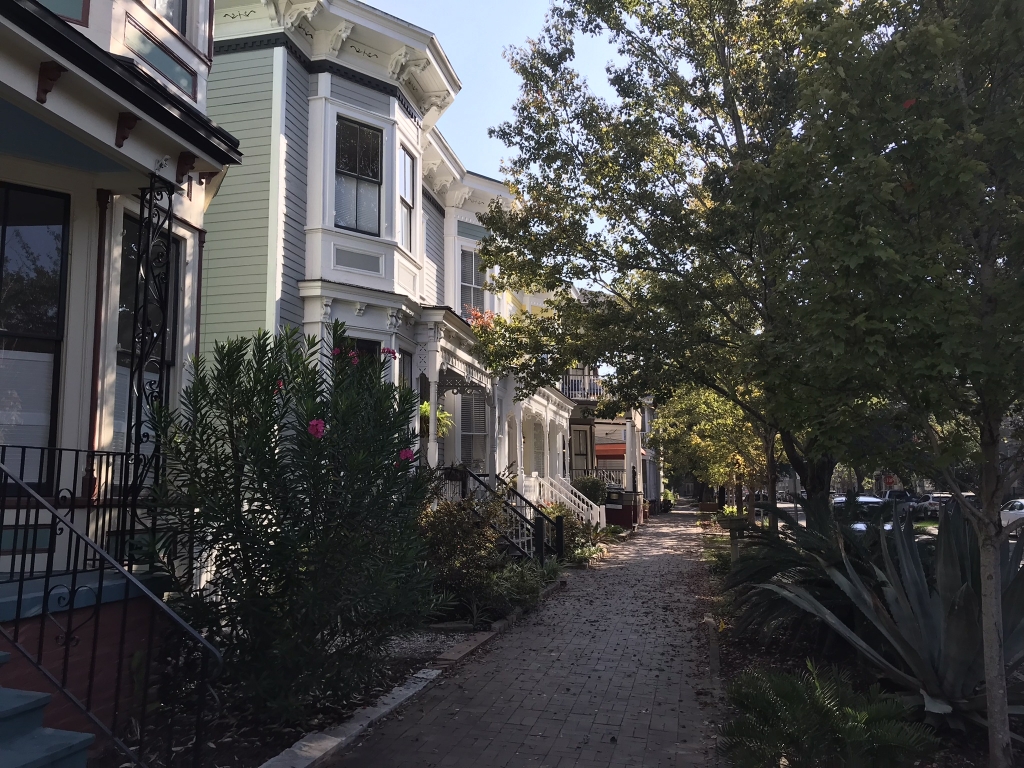
Just a random shot of some houses on one of the streets in the middle of Savannah. I wish I could live in a house like this.
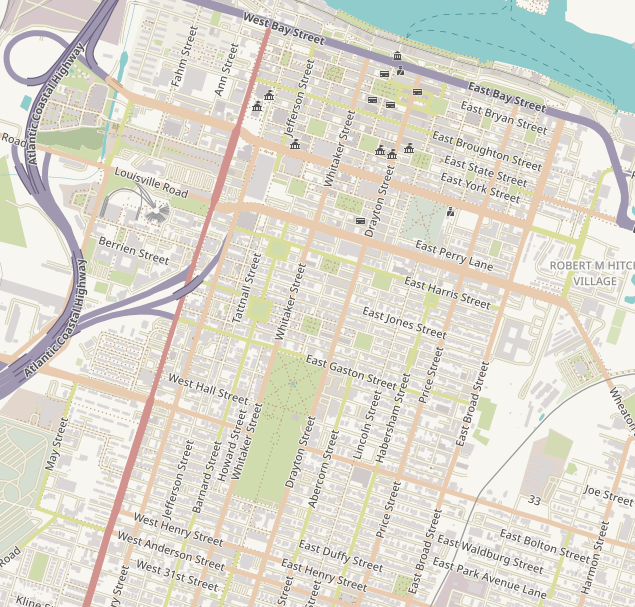
I made this map for the last blog about Savannah, when I visited in 2021, and it's worth another look here. The center of the city--I have a hard time calling this "downtown" because it doesn't really feel like it--is built around all these green squares. The next day of this trip, when I was visiting the Savannah Museum, I discovered that these squares were once the centers of little neighborhoods called "wards." In every ward, the city blocks adjoining the squares to the east and west were called "trust lots" where the businesses and public buildings were, while everything to the north and south of the square were "tything lots" where homes, and eventually pubs, were built. Today there isn't much distinction between the trust and tything lots anymore, with many businesses in the tything lots and homes, including the historic Mercer-Williams House, in the trust lots.
In colonial and Revolutionary times, Savannah was composed of only six wards: those built around Ellis, Johnson, Reynolds, Telfair, Wright, and Oglethorpe Squares. The rest of the city grew out from there. There are now 22 wards with squares in the middle. There would have been more, but the city planners abandoned the ward model in the mid 1800s. Why did they do that? This city would be even better if more of it was built this way.
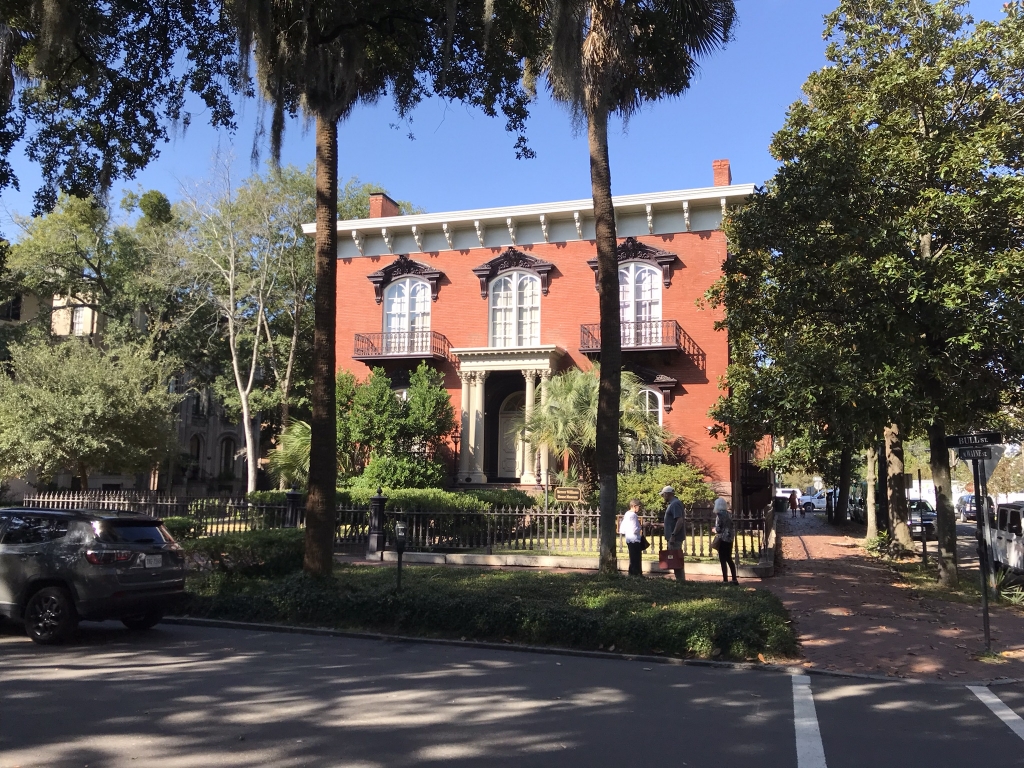
This is the Mercer Williams House, where the preservationist and antiques dealer Jim Williams used to live. Much of Midnight in the Garden of Good and Evil revolved around Williams' unprecedented four murder trials; we'll be back here later in the day when I took a tour of the place.
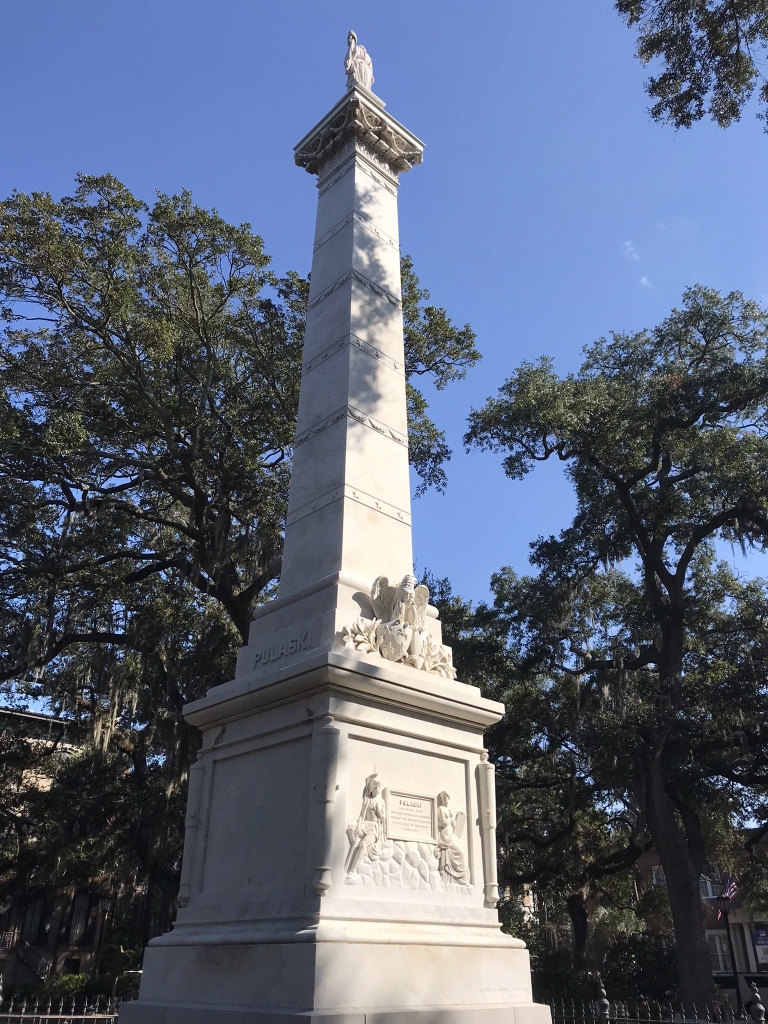
Here in Monterey Square is this monument to Casimir Pulaski, the Polish general who fought on the American side in the Revolutionary War. He was killed in the Battle of Savannah in 1779.
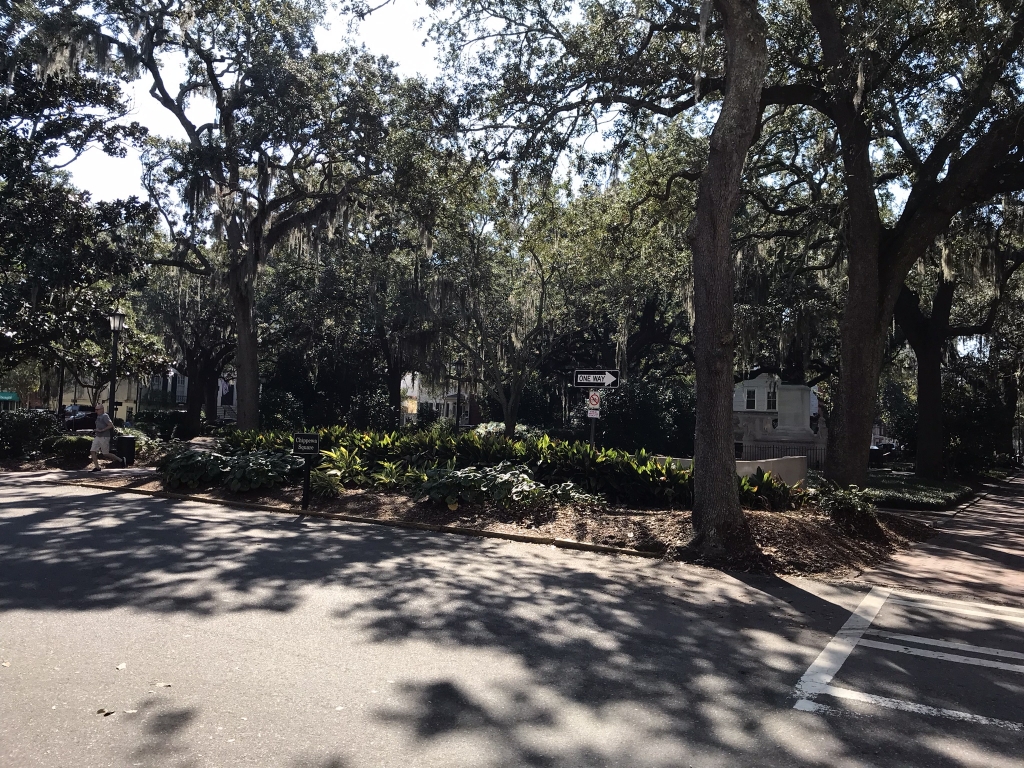
This is Chippewa Square, whose claim to fame is its use in the film Forrest Gump; this is where Forrest was sitting at a bus stop telling everyone his life story. There aren't actually any bus stops on the square; the bench was only placed there for the movie and is now in a museum. But I did go to that museum the next day and take a picture of the bench, which we'll see at that point in the blog.
It was already pretty late in the morning when I had left the hotel, so by now it was time to find something for lunch. Being in a coastal city, that lunch was going to be seafood. After looking around Apple Maps a bit I decided on Sorry Charlie's Oyster Bar, on W. Congress St. just a few steps away from Ellis Square. My lunch there was ceviche--marinated grouper--with tortilla chips. I also got a couple of craft beers: SweetWater Lager, made in Atlanta, was really refreshing, and Service Brewing Rally Point Pilsner, from Savannah, was also good.
Why not get another coffee while I'm at it? A couple blocks west from Sorry Charlie's on W. Congress, next to Franklin Square, I found Bitty & Beau's Coffee. I got a cold brew and a mug with their logo on it. If you're in Savannah, I'd recommend getting something here not just because the coffee is good, but because they employ and thus provide opportunities for people with intellectual disabilities like Down Syndrome.
Now let's go down to the waterfront.

Watch your step on the way down.
Down by the river there's a nice riverwalk with more bars and restaurants and such, although I didn't need those at this moment.
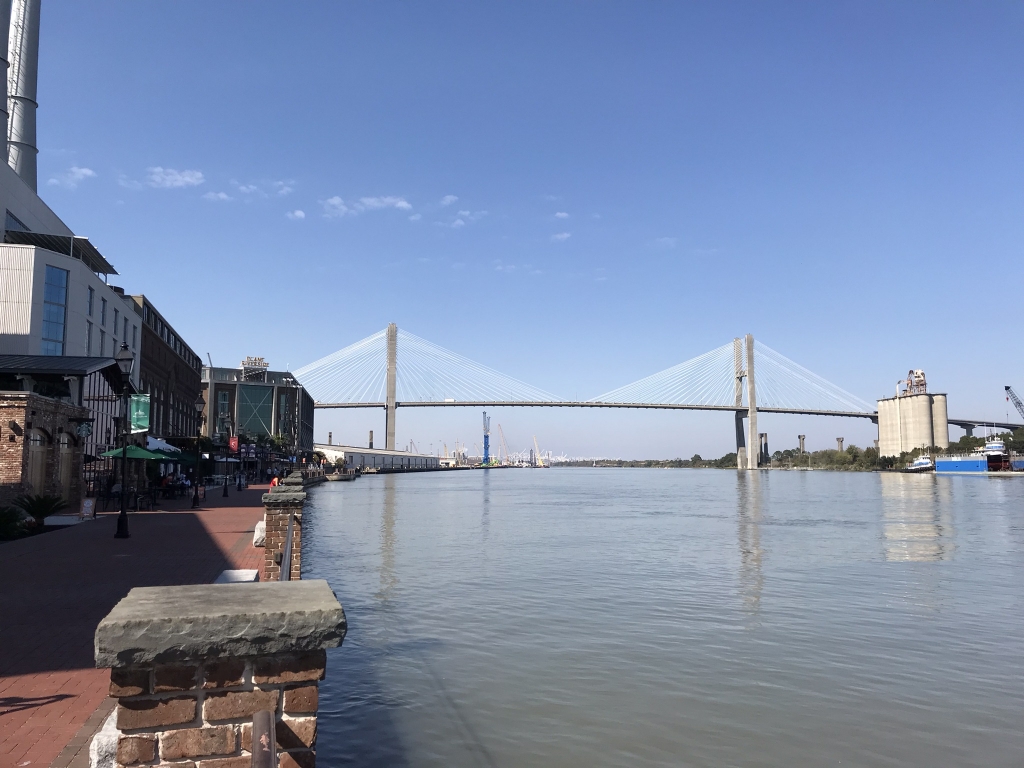
This is the Talmadge Memorial Bridge, over the Savannah River, connecting Savannah (left) with Hutchinson Island (right).
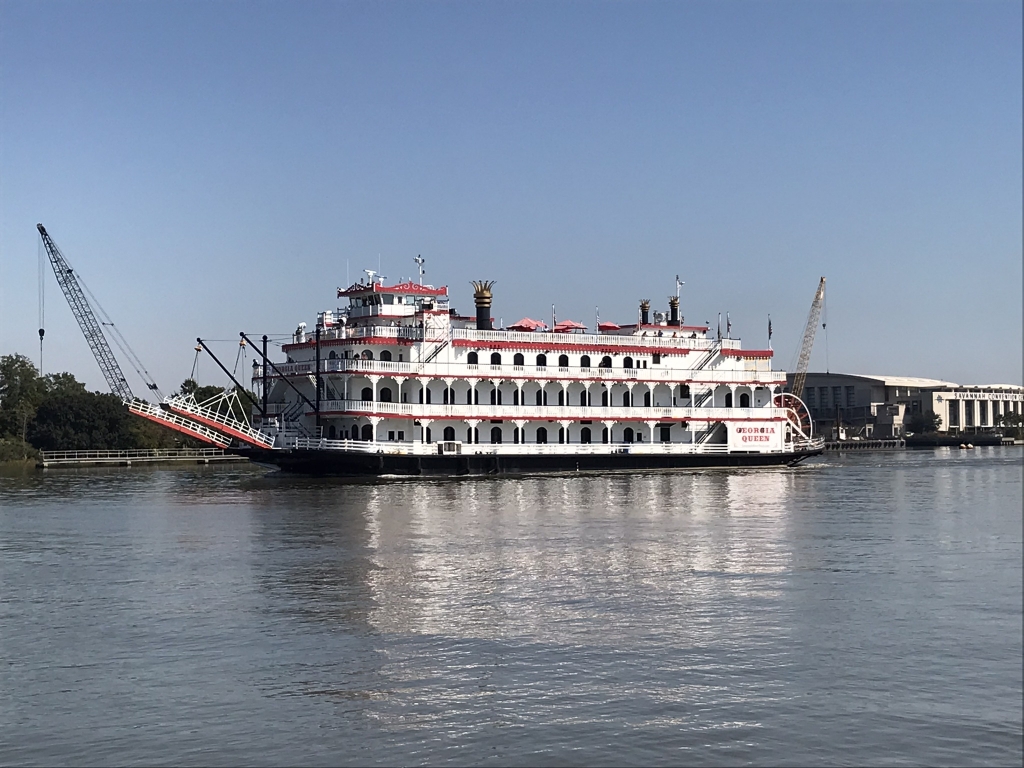
Paddlewheel riverboat Georgia Queen making its way up the Savannah River. I wonder how much it costs to book a cruise on this boat?
Away from the river, I made my way south in the general direction of the Mercer Williams House, where I'd be taking a tour later that afternoon.
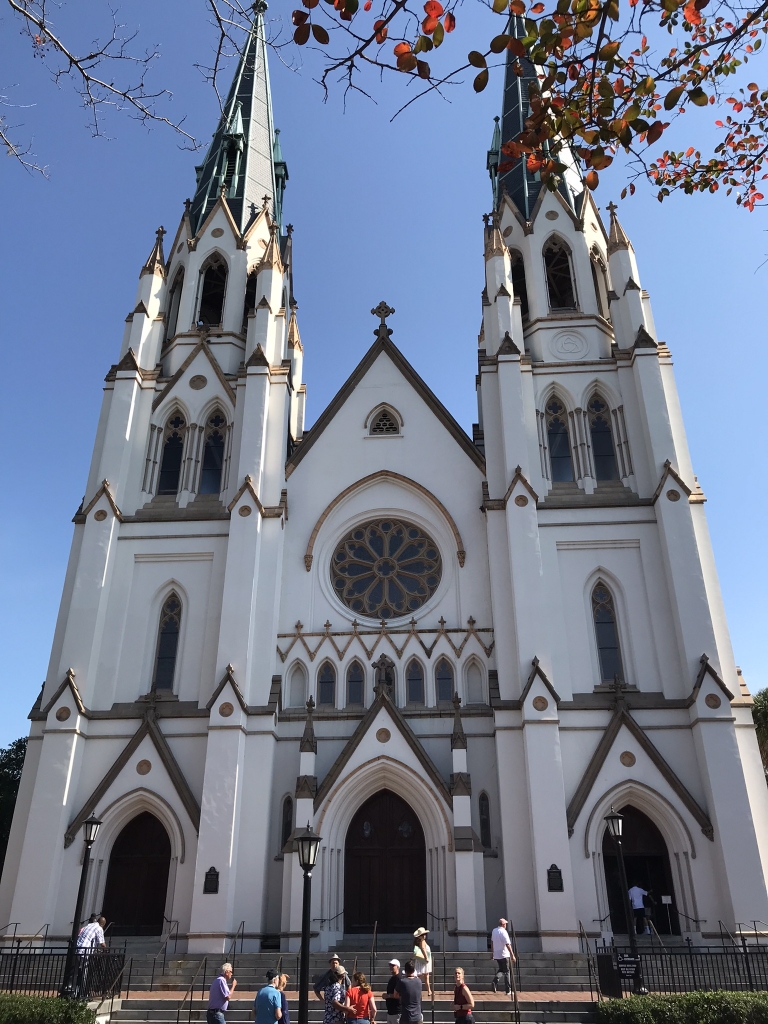
The biggest building on Lafayette Square is this Catholic church, the Cathedral Basilica of St. John the Baptist.
There were a few houses I wanted to see, in which certain scenes from Midnight in the Garden of Good and Evil were set. The first I found was the house Joe Odom lived in at the beginning of the book. Joe Odom, in the book and in real life, was a slippery lawyer and a musician who played the piano in local bars. When we first meet him in the book, he and someone else are splicing power cables outside the house, to steal electricity from the house next door, because Odom hasn't been paying his electric bill while he hosts a non-stop party in his house. That house is at 16 East Jones Street.

"Joe Odom's townhouse was furnished in a manner I would not have expected for the home of a utilities deadbeat. On the parlor floor I saw a fine English sideboard, several good eighteenth-century oil portraits, a pair of antique silver sconces, a Steinway grand piano, and two or three impressive oriental carpets. There were people in every room, it seemed--not quite a party, more an open house."
If the book is accurate, Odom had to sell this this house after a botched real estate deal, but still lived in it as a tenant to a landlord. Shortly thereafter he started making some extra money by leading busloads of visitors to the city on tours through the historic house, which included lunch. But that didn't last long as the house was gutted by a fire, after which the new owner evicted him for never having paid any rent.

This is the home of Congregation Mickve Israel, the oldest Reform Jewish congregation in the US. As a nearby historical marker reads, it was founded by English Jewish colonists who landed in Savannah in 1733, the year of the city's founding. This particular synagogue isn't that old, though. The congregation moved around from one temporary place of worship to another for nearly a century, built their first permanent synagogue in 1820, and finally built this one in 1878. The banner in the door is advertising the "Shalom Y'all Jewish Food Festival." Looks like something I'd want to check out, but it wouldn't happen for another two weeks.
At this time I really needed to use a bathroom, but couldn't find one anywhere! I saw something that looked like a gift shop and dashed inside hoping to find a restroom. And thankfully I did. But because I didn't want anyone working there to think I was just using the restroom and not being a customer of the place, whatever it was, I stayed and looked around.
This particular gift shop was part of the Savannah College of Art and Design, better known as SCAD (pronounced as one word). And there was much more there than a gift shop. There's a series of rooms you can walk through showing you the history of SCAD, including a short animated film about the college's founding. Pretty nice diversion. I'd heard of SCAD but didn't know much about it until this unplanned visit.
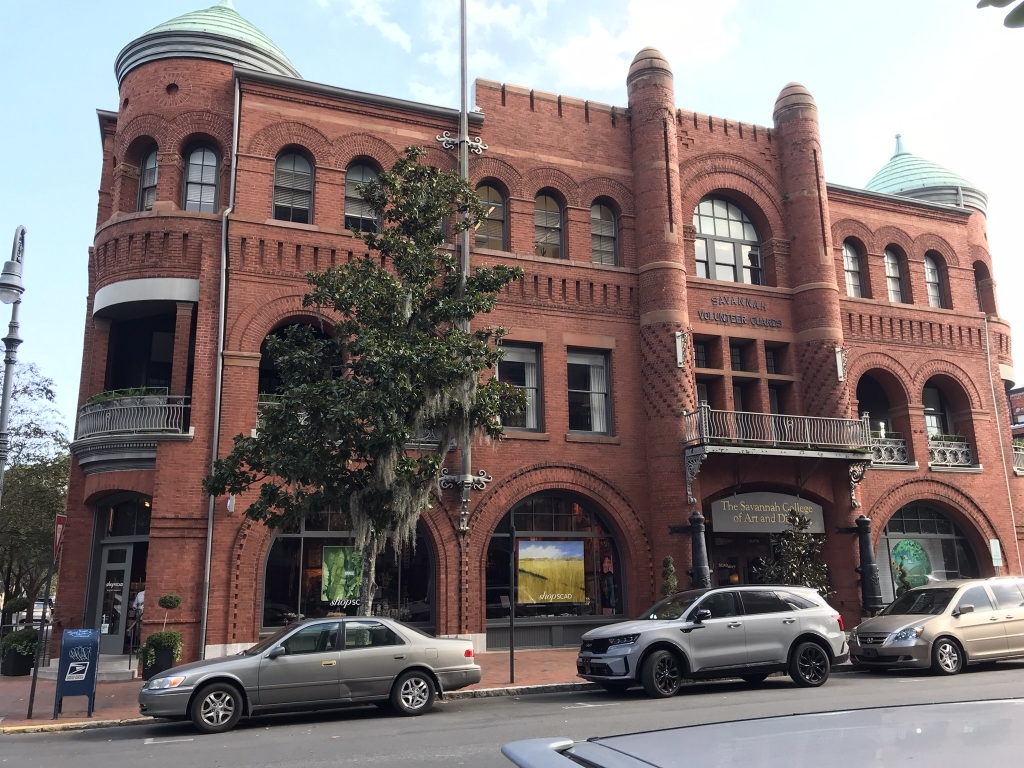
This is the building I had just been in, the SCAD building with the gift shop. This was the first building used by the college, before it acquired more scattered throughout the city. This particular building had originally been a National Guard armory, but was a dusty, abandoned hulk by the time SCAD bought and restored it.
My next stop was the Mercer Williams House for the guided tour. We learned in the tour that construction of this house, originally just known as "Mercer House," was first started in 1860 for Army General Hugh W. Mercer, who joined the Confederate Army during the Civil War which interrupted the house's construction. When the war ended, Mercer sold the unfinished house to cotton merchant John R. Wilder. The house was finally finished in 1868, and no one named Mercer ever lived in it.
Hugh Mercer was the great-grandfather of Tin Pan Alley songwriter Johnny Mercer, who wrote many popular songs of his day, like "Moon River," "That Old Black Magic," "I'm an Old Cowhand (From the Rio Grande)," and "Ac-Cent-Tchu-Ate the Positive."
The house's most famous resident was Jim Williams, a central character in Midnight in the Garden of Good and Evil. He was not only an antiques dealer, who bought antiques from auctions all over the world, restored them in the house, and resold them, but also one of central Savannah's most important preservationists. While Savannah's historic center may be thriving today, during the 1950s and '60s it was considered "blighted," with most of the buildings abandoned and decaying. Jim Williams was crucial in reversing that, by buying, restoring, and reselling these properties. The Mercer House, which he made his home, was the first such property he restored.
Danny Hansford, as he was described in the book, was something of a gigolo who had many lovers of both sexes, who described him as "a walking streak of sex." He was depicted as being reckless, temperamental, and having something of a live-fast-die-young kind of attitude. He had an on-again-off-again affair with Jim Williams who was more than twice his age. One night in 1981 they got into an argument that turned violent, in which Williams pulled out an antique gun and shot Hansford dead. Was this self-defense, or was it murder? That was a surprisingly difficult question and it took four trials--four trials!--which together spanned nearly the entire decade of the '80s, to finally settle it.
In the first trial, Williams was found guilty of murder and sent to prison. But that conviction was overturned, and Williams set free, when new evidence came to light. The second and third trials were both mistrials ending in hung juries. By then, it was impossible to find any unbiased potential jurors in Savannah, as everyone in the city had formed an opinion on the case. That's why the fourth trial was held in Augusta, where no one had ever heard of Jim Williams or his murder case. He was finally found innocent in the fourth trial in 1989.
But Jim Williams only got to enjoy his exoneration for eight months. He died of heart failure and pneumonia on January 14, 1990. The house has since been renamed "Mercer Williams House."
When Midnight in the Garden of Good and Evil was made into a movie in 1997, directed by none other than Clint Eastwood, the film crews found the study too small to set up their equipment and shoot their scenes the way they wanted, so they built a larger replica of the room on a Hollywood soundstage. Our tour guide told us that two other movies were filmed in the house. There was one Civil War movie--I think it was Glory but it may have been Gods and Generals, I can't remember and I've never seen either one--in which at least one scene was filmed in the study. That scene wasn't set in Savannah but in Boston, "because, as we all know, Massachusetts is famous for its palmettos," the tour guide said sarcastically while gesturing at a window.
The other movie filmed in the house, which filmed more scenes there than any other, was something that I'd never seen or even heard of, a direct-to-video epic called The Return of Swamp Thing. Since that movie was released in 1989, I presume it was filmed while Jim Williams was in Augusta for his final trial.
No photos are allowed during the tour, so you'll just have to see it for yourself. It's worth it.
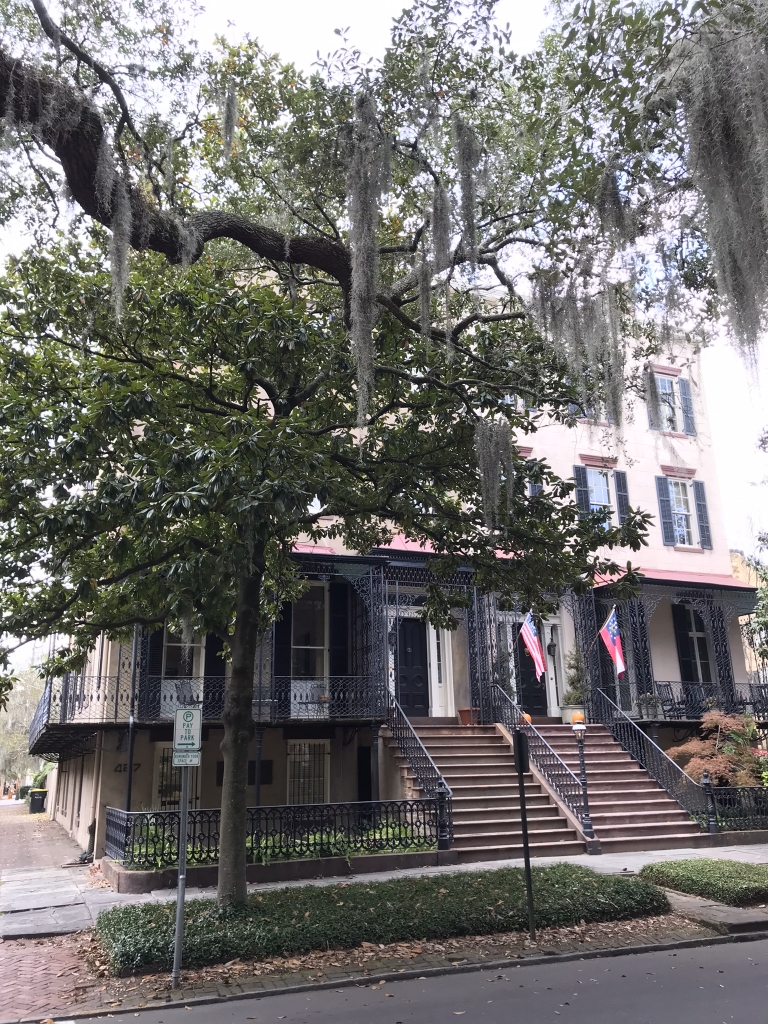
The left half of this duplex, mostly obscured by the tree, is where Lee Adler used to live, at 425 Bull Street. Like Jim Williams, Adler was a preservationist who was deeply involved in restoring Savannah's historic center, buying up abandoned, decaying buildings, renovating them, and selling them to buyers who put them to good use. Adler and Williams didn't get along too well and were often at odds even though they had the same goals
As we already learned, in the middle of the last century the center of Savannah was considered blighted with most properties vacant and falling apart, and all the investment going into newer developments on the outer edges of the city. Today, in the 21st century, whenever old districts fall into disrepair like that, cities usually redirect investment into them, restoring the old buildings and turning them into trendy coffee shops, brewpubs, and vintage clothing stores. But back then, the trend was "urban renewal," which meant bulldozing the blight and replacing it with parking lots and office towers. To see what Savannah's preservationists were up against, take a look at another city I recently passed through...

This is what passes for downtown in Amarillo, Texas. There used to be buildings where those parking lots are, mostly torn down in the '60s. Developers back then were just itching to make Savannah look like this too, and it's thanks to preservationists like Jim Williams and Lee Adler that they didn't.
I stopped at Art's for more coffee. This place is owned and operated by SCAD and there's an entire double-decker bus inside.

This house at 101 East Oglethorpe Street is where Joe Odom moved after being evicted from the other house we saw on East Jones. If the book is to be believed, he hosted tours for tourists through this house, like in the last one, and also just like the last house he was evicted from this one as well for nonpayment of rent.
While on the way to the riverwalk for dinner, I stopped at the Savannah Taphouse, near Broughton & Abercorn a couple blocks north of Oglethorpe Square, for some local beers just after 5pm. Southbound Mountain Jam lager was a local Savannah brew which I thought was OK, but a little too bitter. I also had a Highland Clawhammer Oktoberfest ale, made in Asheville, North Carolina; that one was better, and even served in a Warsteiner mug.
Down by the river there were so many seafood restaurants to choose from, and I went with Dockside. First I got myself another beer, something that I don't usually drink: SweetWater 420 IPA. It was a little too bitter for my taste, but being an IPA I expected that. For dinner I got a "Savannah salad" which was spinach, lettuce, orange slices, hot honey bacon dressing, and cheese blocks, topped with some delicious mahi-mahi.
Before heading back to the hotel I made one more stop by the river, Rusty Rudders. I had another local Savannah beer, Classic City lager. It was OK but not great. I think I had a shot or two of some liquor or another before leaving.
I tried to ride a bus back to the hotel, but the one I was waiting for never showed up so I had to go with an Uber.
Wednesday, November 1, 2023
I would be leaving Savannah for Atlanta later that day, so I had to pack up and check out of the hotel. But since I wouldn't be leaving until the late afternoon, the staff let me leave my stuff behind the desk in the lobby.
Bus 14, my ride to the city center, was a little late due to an accident backing up traffic. When I arrived downtown, I stopped for a coffee at a place called Franklin's, at Liberty & Bull. I got an americano and a pastry. This was a nice place but too crowded, and the service took too long. Maybe I was there during peak hours.
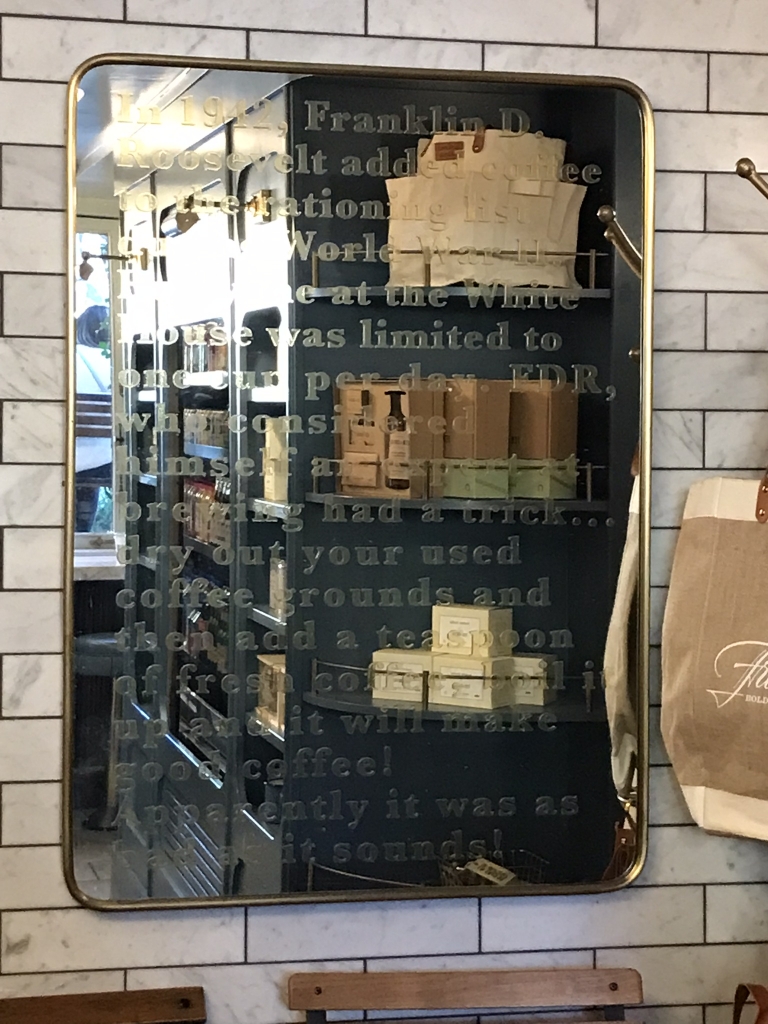
On the wall at Franklin's. "In 1942, Franklin D. Roosevelt added coffee to the rationing list during World War II. Brew at the White House was limited to one cup a day. FDR, who considered himself an expert at brewing had a trick...dry out your used coffee grounds and then add a teaspoon of fresh coffee, boil it up and it will make good coffee! Apparently it was as bad as it sounds!"
It was already about time to find something for lunch, so it was back down to the river. On the way to a restaurant I passed by a tribute to someone else from that book I keep referencing...
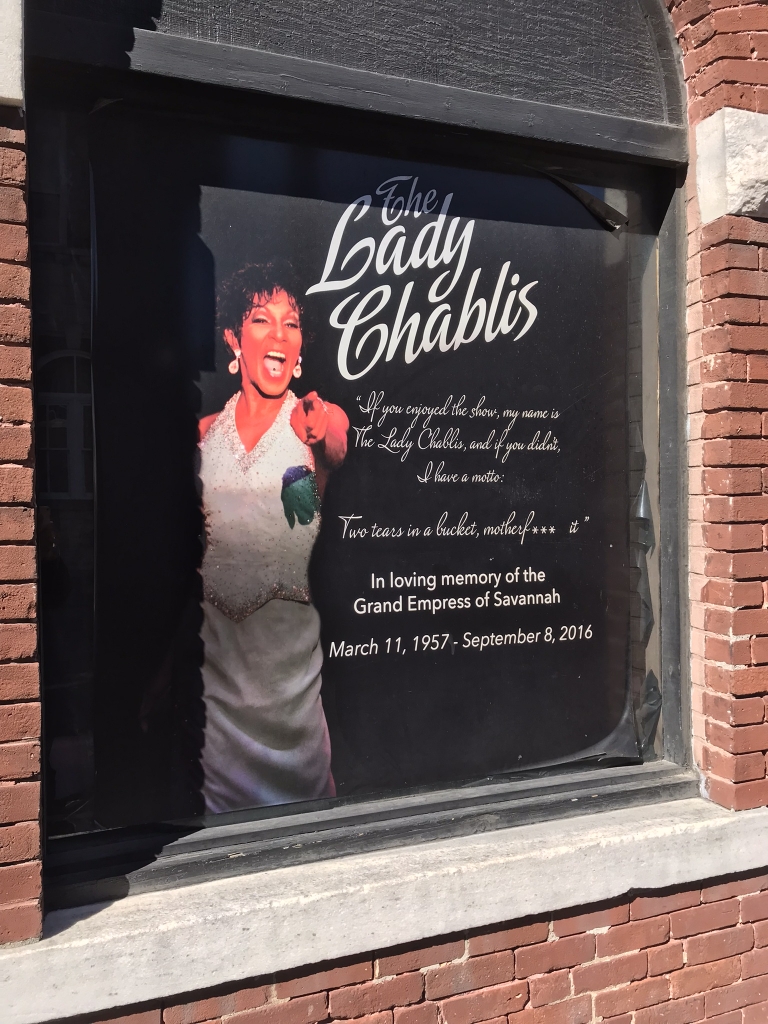
The Lady Chablis, the "Grand Empress of Savannah," was one of the most memorable people in Midnight in the Garden of Good and Evil, and one of the first transgender celebrities. She was known around Savannah for performing in drag shows, although she didn't like being called a "drag queen"--drag is a performance and she was just being herself. She played herself in the movie based on the book, which made her much more well known nationally. "If you enjoyed the show, my name is The Lady Chablis, and if you didn't, I have a motto: Two tears in a bucket, motherfuck it."
I got my lunch from another seafood place, River House. I got a Harvest Salad, made with sliced apples, pecans, onion, goat cheese, arugula, and strawberry vinaigrette, and topped with mahi mahi. Yeah, the same fish as last night, it's not the easiest fish to find in my local grocery stores in eastern New Mexico.
Next I found my way to the adjoining Savannah History Museum and Georgia Railway Museum. Outside this complex were a large number of memorial stones like these...
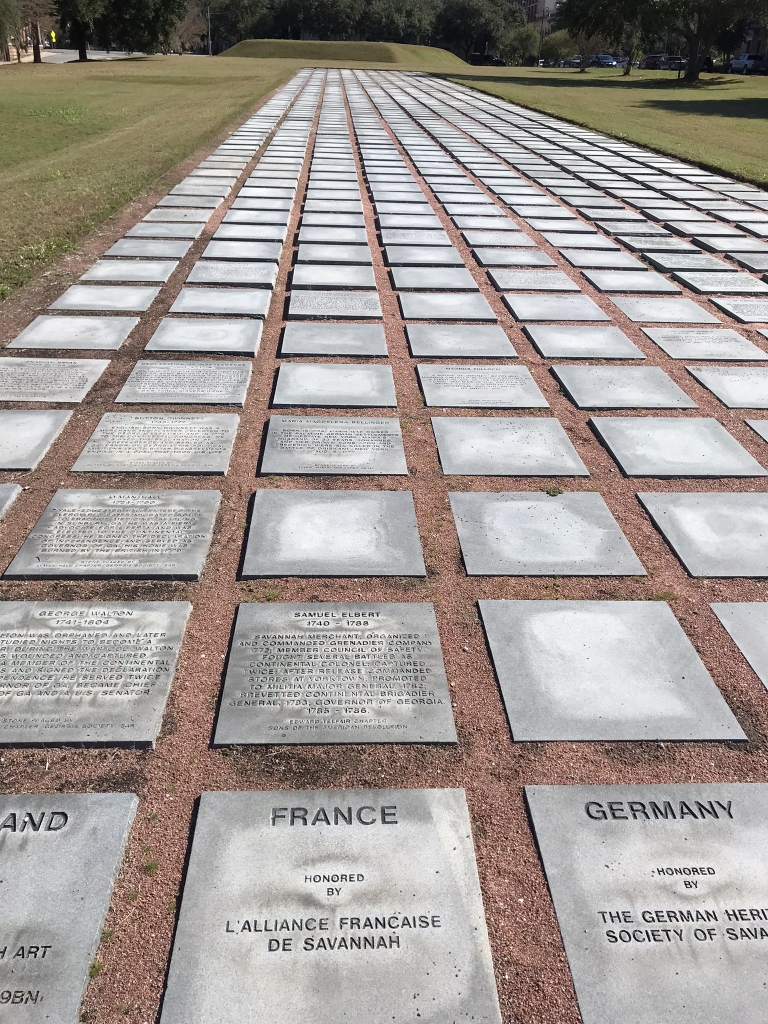
It's rather hard to read the stones in this and other photos I took. They all memorialize countries and people who fought on both sides of the 1779 Battle of Savannah in the American Revolution. Those countries like Ireland, Scotland, Poland, France, and Germany in addition to the USA. The people included Kazimierz (Casimir) Pulaski, Tadeusz Kosciuszko, Bernardo de Galvez, and Sutton Gwinnett. These stones were placed by local chapters of organizations like the Sons of the American Revolution and Alliance Française.
The Battle of Savannah was a disastrous defeat for the American Patriots and their French allies. Nearby an informational sign explains how multinational the battle was. Not only did French troops fight alongside their American allies, the French troops also included Black soldiers from Haiti, as well as an Irish regiment serving the King of France. The Polish nobleman Casimir Pulaski, commissioned as a Brigadier General in the Continental Army, commanded the American cavalry and was killed in the battle. In the city center, one can find a monument to the Haitians in Franklin Square, and to Pulaski in Monterey Square which we already saw the day before. But it was, again, a defeat for the Revolutionaries, and as the sign says, the battle "rekindled England's spirit for the war, in part because the victory defeated troops of the regular army of France as well as American rebels."
Next, we move into the Georgia Railway Museum...
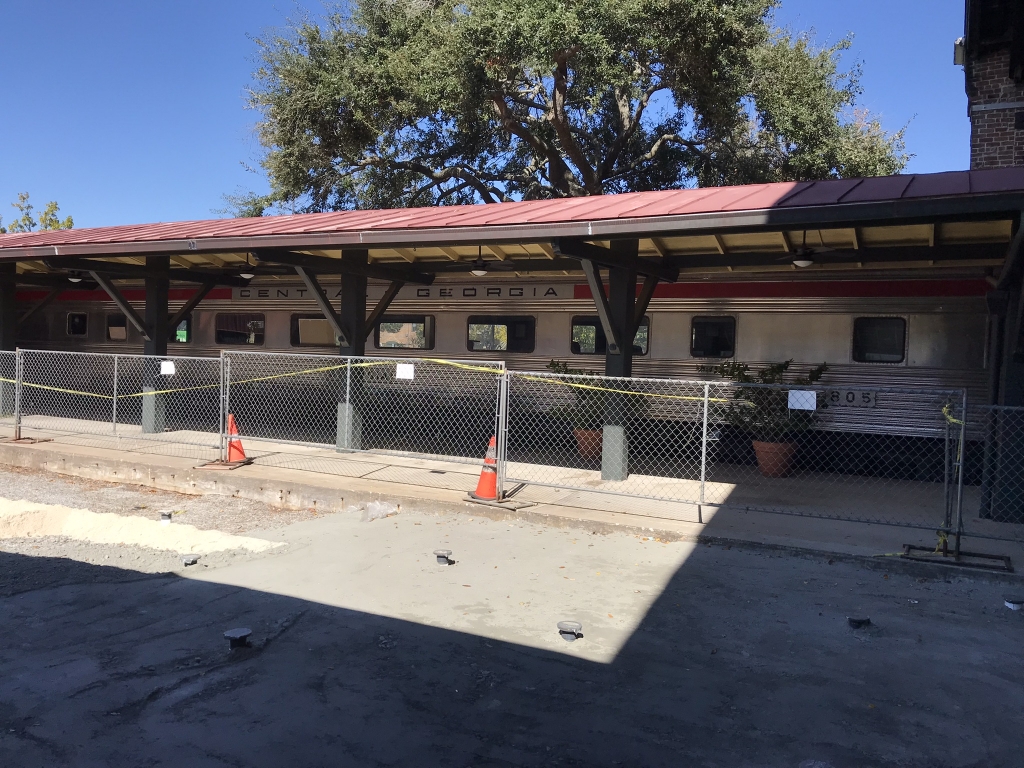
A vintage passenger rail car, from the erstwhile Central of Georgia Railway, outside the Railway Museum.
There were guided tours available, but I unfortunately didn't have enough time, so I had to just settle for a quick walkthrough. Next time I'm in Savannah I'm doing the guided tour.
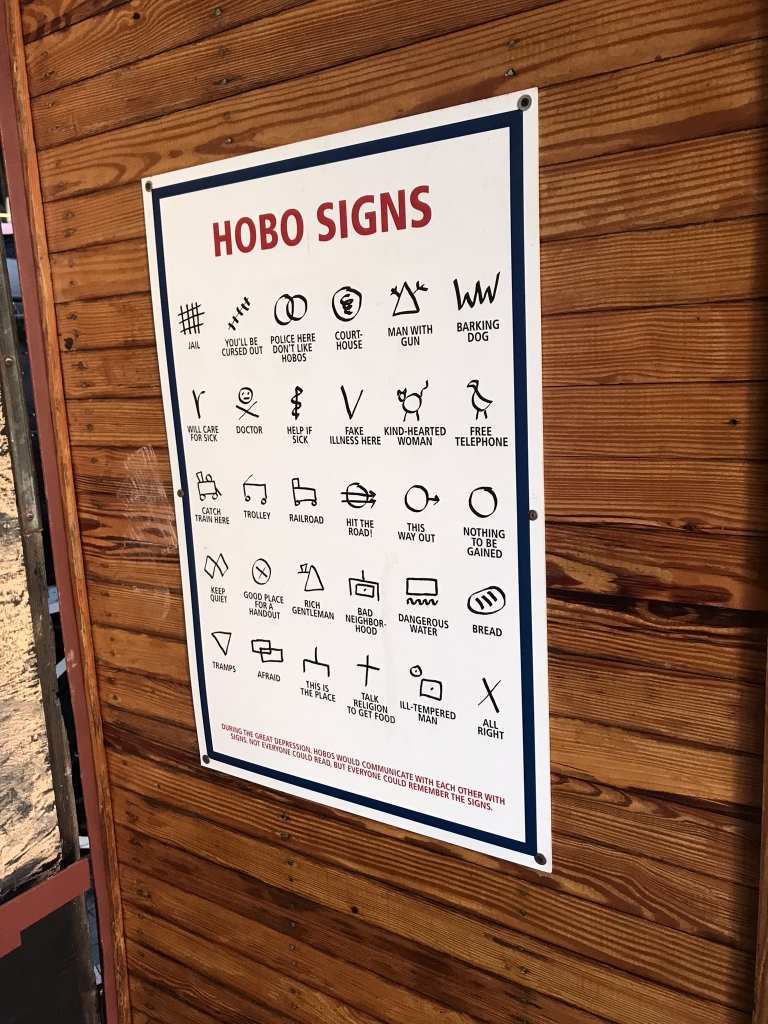
Hobos used to get around the country by hitching rides on freight trains. They also used to leave these signs for each other to let each other know what to expect in the towns they found themselves in.
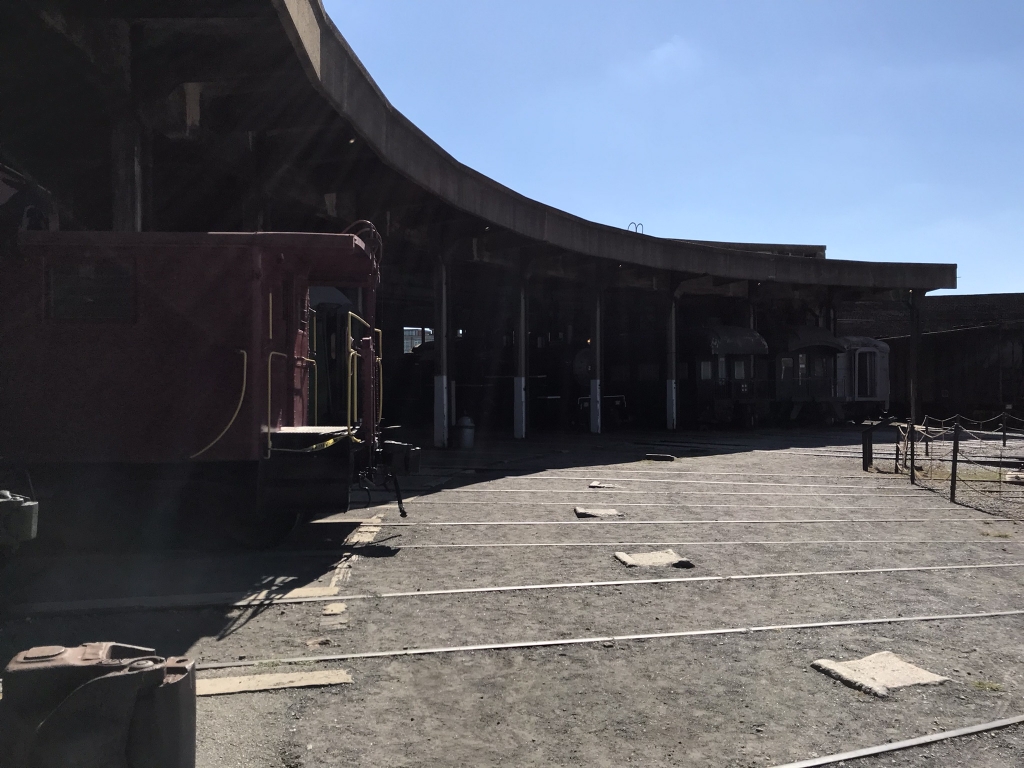
There's an old repair yard here, which has been converted into the museum of today. In most of these bays are railcars of various types and eras.

Here's an old passenger car from the Southern Railway. You can actually step inside this one!
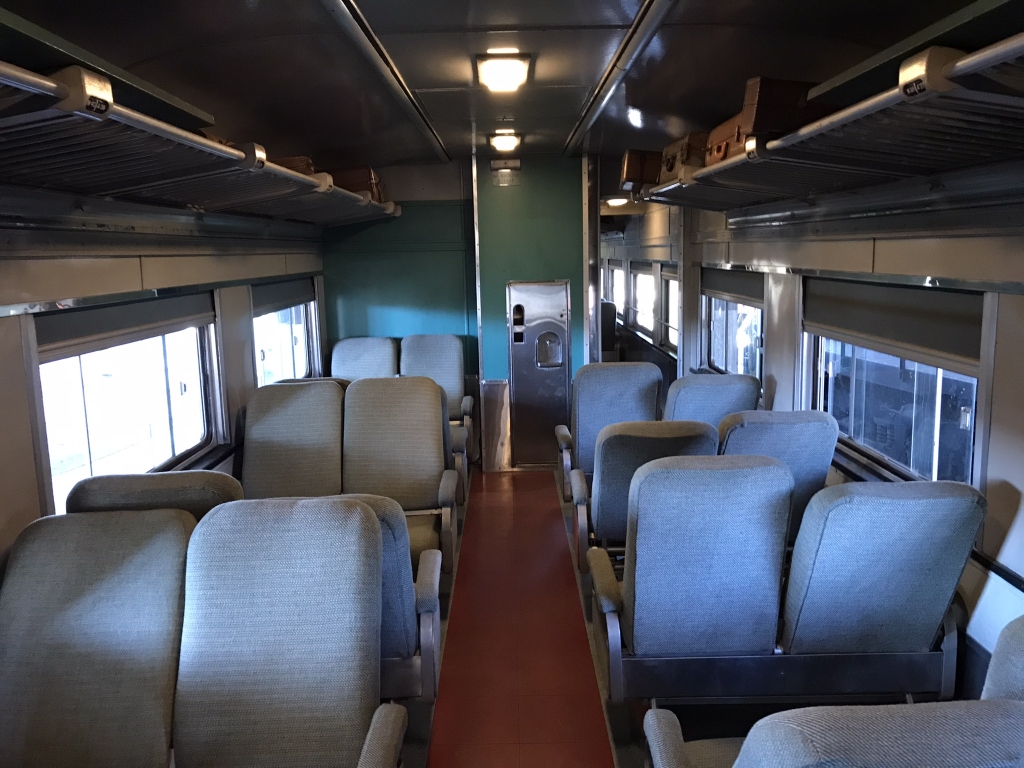
Aboard the Southern passenger car. Looks to be from the WWII era or so.
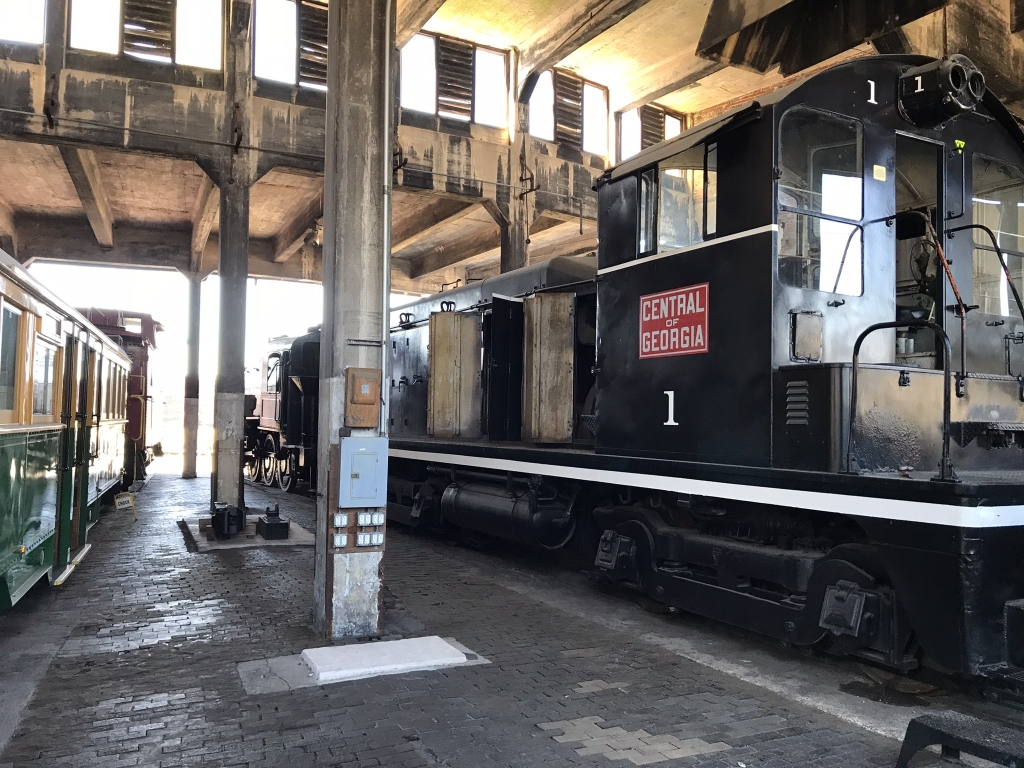
Here's an engine from the Central of Georgia Railway.
The Central of Georgia Railway and Southern Railway have both since been rolled into Norfolk Southern, one of today's big nationwide freight railways.

The railyard's old machine shop, kept preserved in its old state.
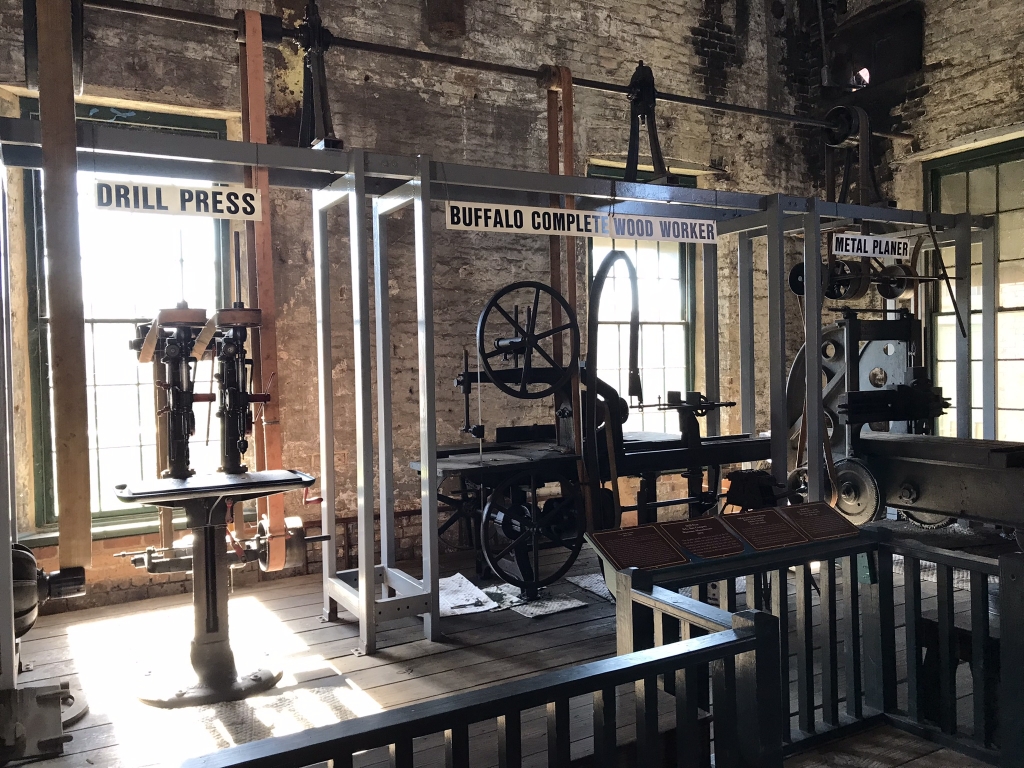
Equipment once used to maintain trains.
There's more to see here and I'm definitely returning to this museum next time I visit Savannah. The guided tour certainly is more of an educational experience.
Now, we'll enter the neighboring Savannah History Museum. At this point I had enough time to look around a little bit.
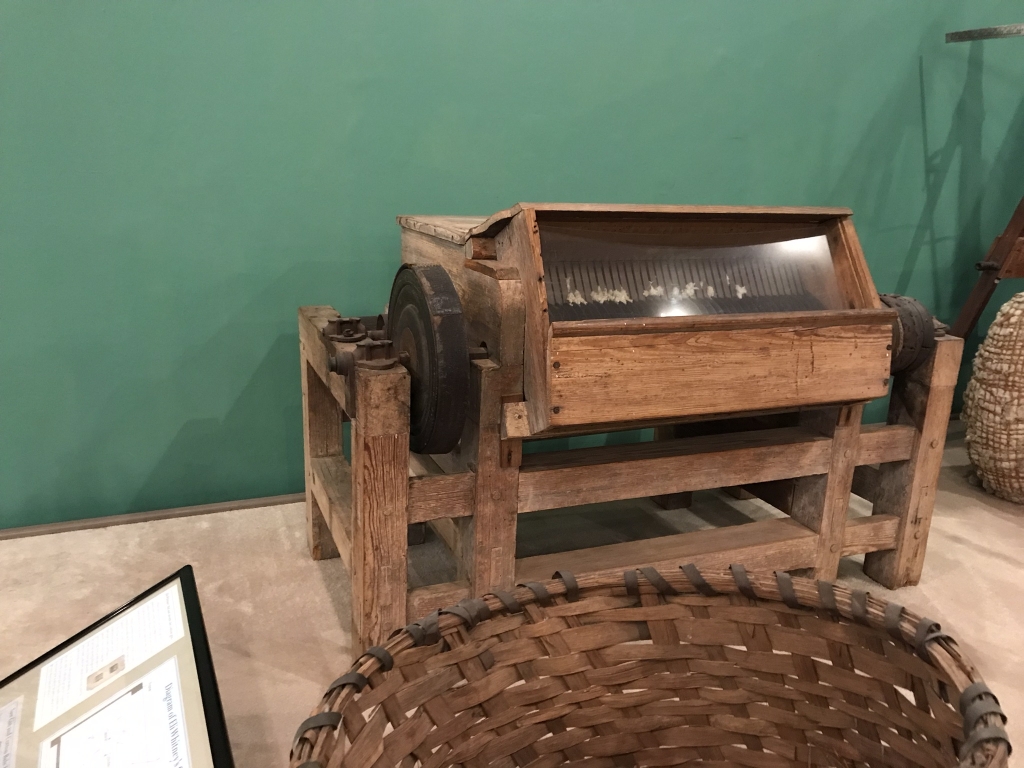
You've certainly heard of the cotton gin before. It made the process of removing seeds from cotton fibers far easier than doing it by hand, but in doing so, this invention also caused slavery to expand in the South. But have you ever actually seen a cotton gin, or even known what it looked like? Here's one! While someone turned a crank on the side, you'd feed raw cotton into the hopper, the teeth--or saws in this one--as they rotated would rip the seeds out, the seeds would fall out of the hopper in front of the device, and the seedless cotton would dump out of the bottom of the machine.
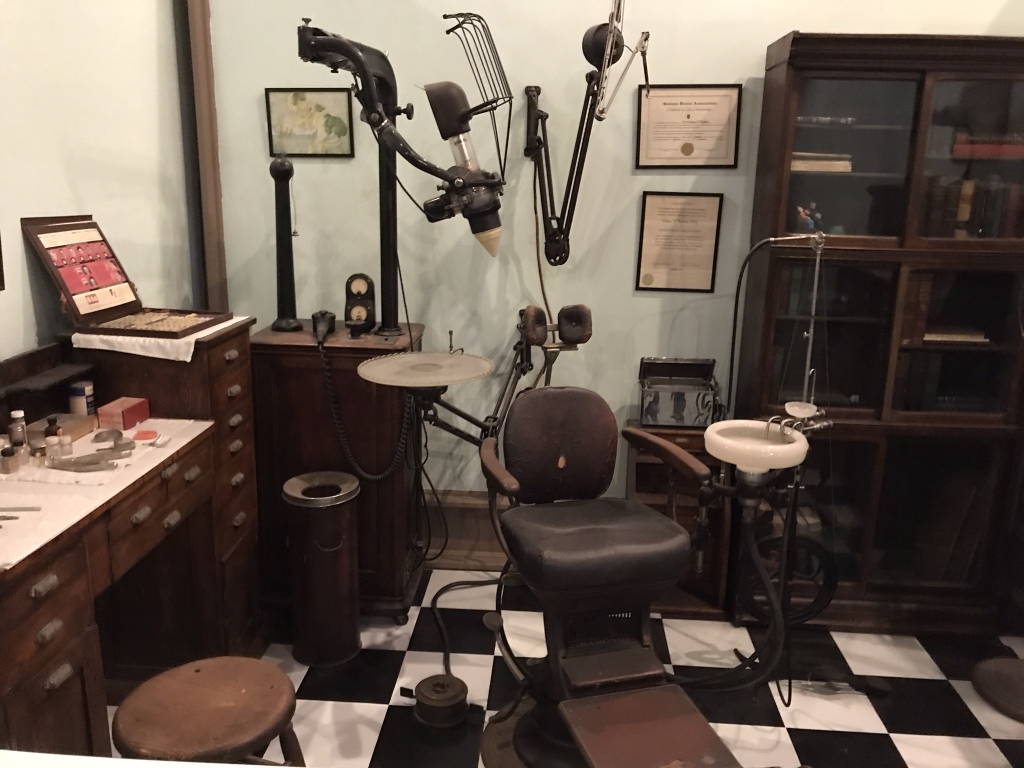
This was Dr. William T. Belford's dentistry office in 1919. He was still using all this equipment all the way up until his death in 1980. As a nearby sign explains, the United States and especially the South had a severe dentist shortage from the 1920s through the '50s. It seems that during WWII the military had to relax its dental requirements for new recruits because far too many didn't have the necessary three matching pairs of front and back teeth. As late as 1955 one in four Georgia counties didn't have a dentist.
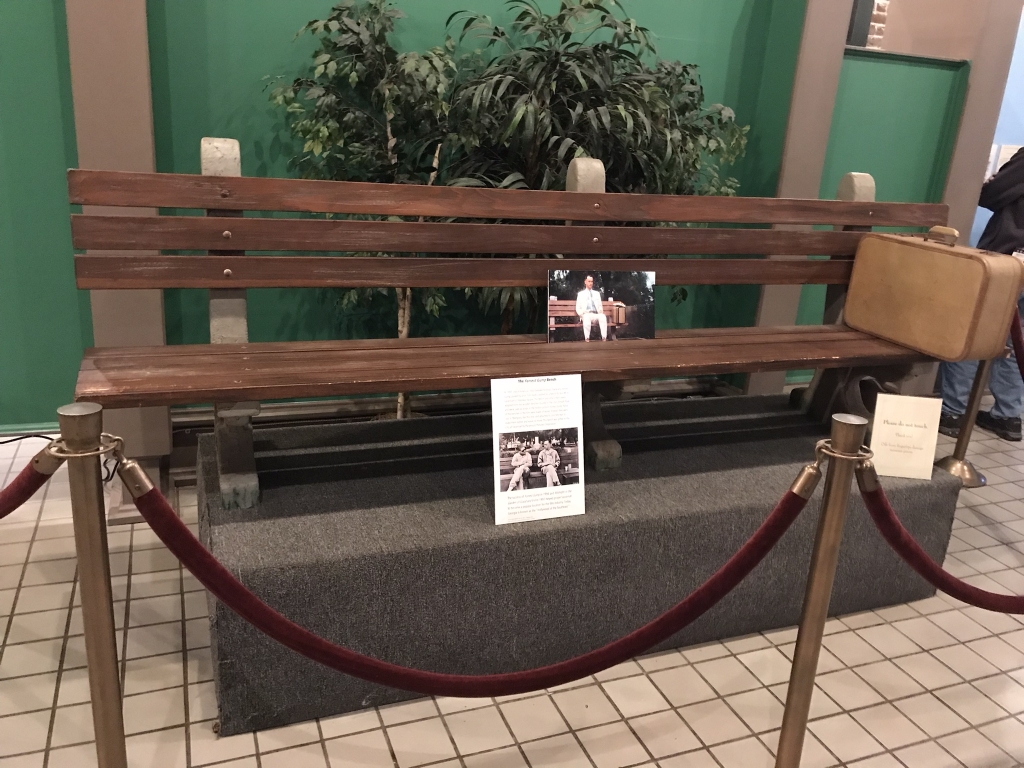
And now here's the Forrest Gump bench, where Forrest was sitting in Chippewa Square in the movie.
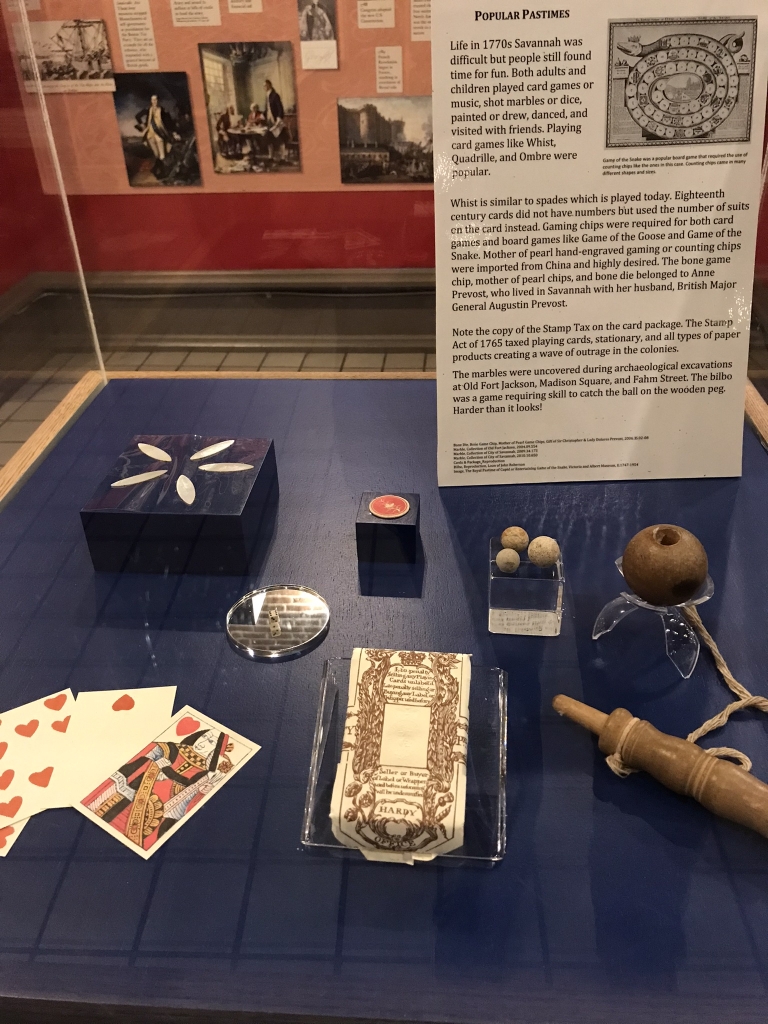
This display case is full of pastimes that 1770s Savannah people used to occupy their free time with. That includes dice, marbles, and playing cards. Cards back then didn't have numbers printed on them, as you can see, you only knew the number of the card by counting how many hearts/diamonds/spades/clubs were on it. That device on the right is called a "bilbo" and the idea was to catch the ball on the peg. That box that the cards were in needs a closer look...
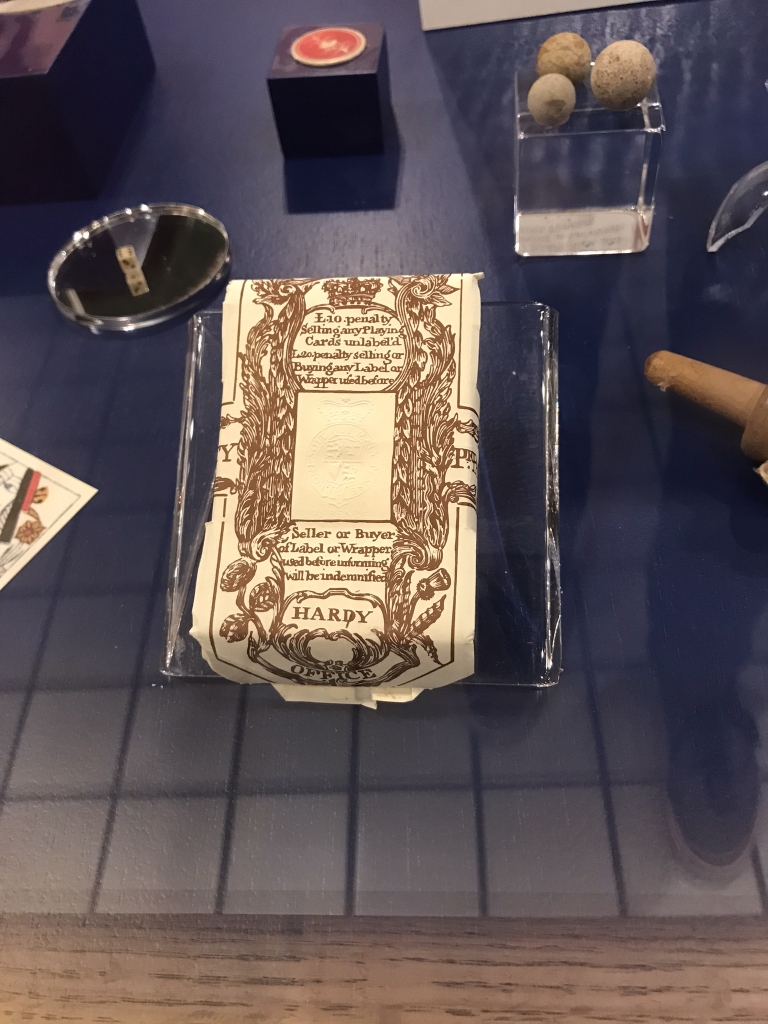
It's hard to see but this box has a stamp--not ink but an impression in the paper--on it, in the center. It's the infamous tax stamp, the kind that was one of the causes of the Revolution.
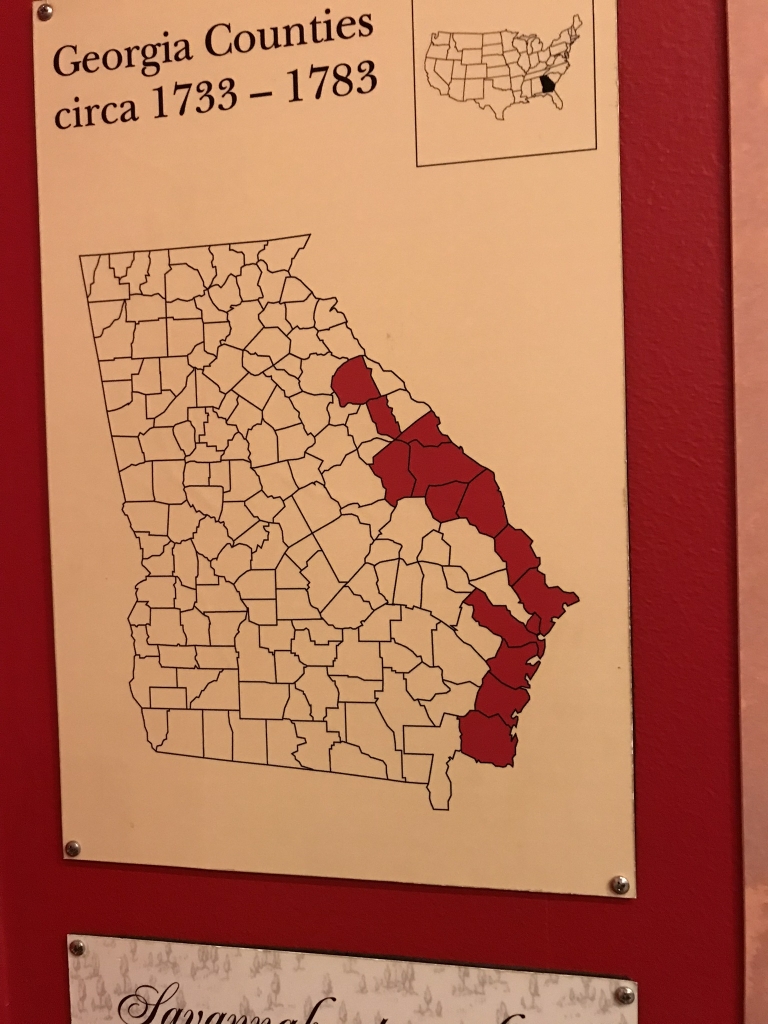
Here you can see how much Georgia has grown since the colonial era. The red-shaded counties were the only English-settled areas back then. In the center of the boomerang shape is Savannah, back then the capital and largest city, built at the point where the Savannah River meets the Atlantic Ocean. At the northwestern tip is where you'll find Augusta, which at that time was Georgia's second-largest city. At the southern tip is Brunswick, at that time Georgia's third-largest city, today pretty small but still an important seaport.

This is a wall from the Sheftall-Kent house, or "Cannonball House." The house used to stand near Telfair Square, then known as St. James Square, and was owned by the Sheftall family, one of Savannah's most prominent Jewish families and supporters of the Revolution. It took a hit from a cannonball during the battle in 1779 and the hole left from it has been preserved here.
In the museum's gift shop, I bought a bag of locally-milled corn grits, along with two books: James D. Porterfield's Dining by Rail and Jacqueline Jones' Saving Savannah: The City and the Civil War. The first of those books is full of authentic recipes used on the dining cars of American railways during the late-1800s/early-to-mid-1900s "Golden Age" of American railways. I've since cooked one of them, a chicken Mulligatawny stew once served on the Atlantic Coast Line in the southeastern states. It was pretty delicious! As for the second book, I've sadly not gotten to it yet but it's in my queue for later this year. The grits, of course, I finished off months ago.
Well, I wanted to look around the museum more, but I didn't have any more time. I had to spend about an hour riding a bus all the way from the museum back to the hotel. Knowing I wouldn't have time to get a real dinner anywhere, I bought myself some cheese and crackers from a nearby convenience store. After reclaiming my luggage from the hotel, I spent another hour on a bus heading back into the city center to the Greyhound station. You know, I think Savannah's bus system may be a tad inefficient for the city's size.
The Greyhound bus I would be riding that evening was going to take me to Atlanta, with one stop in Macon. Sometime in the next decade, Amtrak, as part of their rail expansion plans, will start a service that travels that same route. When that train finally makes its debut, I'll definitely be riding it, but until then I have to settle for this cramped bus...
Hulaween 2023 Trip:
- Hulaween 2023, and Associated Bumbling Around Atlanta and Jacksonville
- Returning to Savannah in 2023
- My First Real Look at Atlanta

